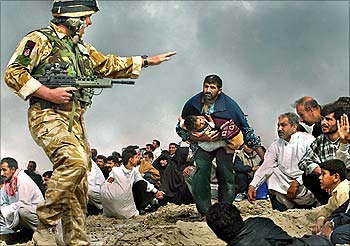Camera Always Lies, The
Breaking the Myth of Journalistic Objectivity
In line at the supermarket, you notice a photo on the cover of a news magazine. But it may not be what it appears to be. New technology has created the possibility to alter photographs, with precision and quality, in a completely undetectable manner. Digital manipulation of photographs is happening more and more often these days, usually going unnoticed and without comment.
Predictably, this technology is creating ethical dilemmas for both journalists and readers. Many journalists view themselves as objective recorders of reality and depend on the public's faith in the words and images they communicate. By the same token, readers and viewers use the media as their primary source of information about the world around them, and depend on journalists to depict that world as accurately as possible. In the context of democracy, journalism fills a vital role: It is how citizens get the information they need to become an informed electorate. If journalism loses the public's trust, it can throw a monkey wrench into the democratic process.
While some journalists detest computer manipulation of photographs, many editors and publishers are more than happy to take advantage of the potential to create the perfect image - and maybe sell a few more newspapers or magazines.
Altering photographs was not so easy until computers came along. In 1982 the public was outraged to learn that National Geographic had digitally moved the pyramids in Egypt closer together to fit the magazine cover's vertical format. There was another stir when Time magazine darkened a picture of O.J. Simpson on its cover, and again when Newsweek digitally straightened the teeth of the mother of septuplets. In the U.S., many publishers, backed by court rulings, justify altering cover photographs by insisting that the cover of a magazine is advertising and not journalism. Funny, it doesn't look like an ad! How's a reader to know?
The practice of digitally doctoring photographs is so commonplace today that it came as a surprise when in April 2003 the Los Angeles Times fired staff photographer Brian Walski for submitting a photograph, during the Iraq War, of a British soldier guarding Iraqi civilians. The dramatic photo was actually a composite of two separate photographs which he had merged in his computer. On March 31 the photograph ran on the front page of the Times, as well as in the Chicago Tribune and the Hartford Courant.
 Photos by Brian Walski |
 |
 |
When the composite was discovered, the Times stated that Walski was fired because "Times policy forbids altering the content of news photographs."
License to Lie? Or Tell the Truth?
This new technology should not be perceived as a new license to lie, but rather as a new opportunity to finally tell the truth: Photographs are never objective. Think about it. The very nature of photography – the instantaneous capture of images recorded by light reflected onto film – creates the illusion that a photograph is an objective document. After thousands of years of seeing the world around them depicted only through paintings, drawings, and sculptures, humans were amazed by the ability of the first photographs to represent objects or people with the most intricate detail and realism. The scientific process of chemicals reacting to light, and the resulting image that at times looks more real than the object it represents, gives photography a seeming authenticity and credibility more powerful than it deserves.
 Unfortunately, widespread understanding of the nature of photography has progressed little since Joseph Nicephore Niepce took the first photograph in 1826, nearly two centuries ago. Most people still voluntarily give photographs authoritative power, instead of understanding a photograph to be merely one individual's perspective of one moment in time.
Unfortunately, widespread understanding of the nature of photography has progressed little since Joseph Nicephore Niepce took the first photograph in 1826, nearly two centuries ago. Most people still voluntarily give photographs authoritative power, instead of understanding a photograph to be merely one individual's perspective of one moment in time.
The belief that "the camera never lies" betrays the fact that someone chose what, when, where, why, and how to photograph. Every step a photographer makes in taking a picture involves subjective choices, from the camera angle (looking up, looking down, eye level) to the framing (what to include and what to leave out) to the moment of exposure (when to shoot and when to wait). A photograph is always a decontextualized representation of reality recorded by a human being who makes conscious and even unconscious choices based on his or her cultural upbringing, experiences and biases. Joan Fontcuberta, editor of the Spanish magazine PhotoVision, insists that the phrase "manipulated photography"1 is a redundancy, since every photograph is manipulated.
Over a decade ago, magazine editor Fred Ritchin warned: "In order to contemplate its future role in society and the impact of new technologies, it is necessary to at least acknowledge that photography is highly interpretive, ambiguous, culturally specific, and heavily dependent upon contextualization by text and layout."2 For too long, too many media consumers have been laboring under the false assumption that photographs show the world "as it is" because the camera supposedly never lies. This myth of objectivity has contributed greatly to photography's power in society. Perhaps, given time, the practice of digital manipulation will shed light on the multiple manipulations that occur even before the shutter snaps.
1Joan Fontcuberta, "Pedro Meyer: Truths, Fictions, and Reasonable Doubts," in Pedro Meyer, Truths & Fictions: a journey from documentary to digital photography, New York: Aperture, 1995, 12.
2Fred Ritchin, In Our Own Image: The Coming Revolution in Photography, New York: Aperture, 1990, 81.


